steering JEEP RENEGADE 2018 Owner handbook (in English)
[x] Cancel search | Manufacturer: JEEP, Model Year: 2018, Model line: RENEGADE, Model: JEEP RENEGADE 2018Pages: 356, PDF Size: 6.11 MB
Page 70 of 356
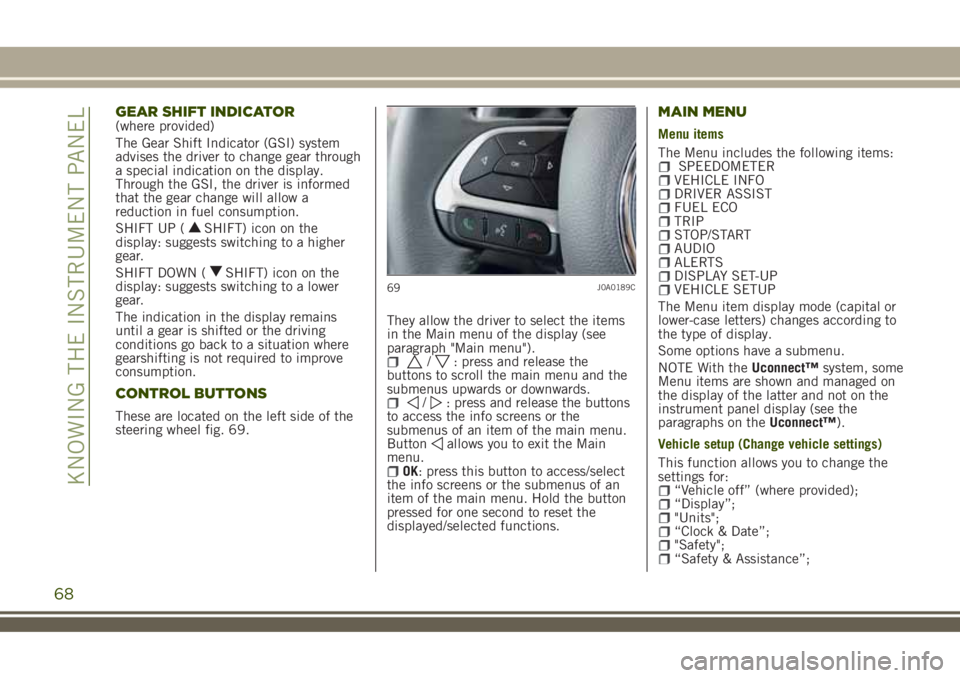
GEAR SHIFT INDICATOR(where provided)
The Gear Shift Indicator (GSI) system
advises the driver to change gear through
a special indication on the display.
Through the GSI, the driver is informed
that the gear change will allow a
reduction in fuel consumption.
SHIFT UP (
SHIFT) icon on the
display: suggests switching to a higher
gear.
SHIFT DOWN (
SHIFT) icon on the
display: suggests switching to a lower
gear.
The indication in the display remains
until a gear is shifted or the driving
conditions go back to a situation where
gearshifting is not required to improve
consumption.
CONTROL BUTTONS
These are located on the left side of the
steering wheel fig. 69.They allow the driver to select the items
in the Main menu of the display (see
paragraph "Main menu").
/: press and release the
buttons to scroll the main menu and the
submenus upwards or downwards.
/: press and release the buttons
to access the info screens or the
submenus of an item of the main menu.
Button
allows you to exit the Main
menu.
OK: press this button to access/select
the info screens or the submenus of an
item of the main menu. Hold the button
pressed for one second to reset the
displayed/selected functions.
MAIN MENU
Menu items
The Menu includes the following items:
SPEEDOMETERVEHICLE INFODRIVER ASSISTFUEL ECOTRIPSTOP/STARTAUDIOALERTSDISPLAY SET-UPVEHICLE SETUP
The Menu item display mode (capital or
lower-case letters) changes according to
the type of display.
Some options have a submenu.
NOTE With theUconnect™system, some
Menu items are shown and managed on
the display of the latter and not on the
instrument panel display (see the
paragraphs on theUconnect™).
Vehicle setup (Change vehicle settings)
This function allows you to change the
settings for:
“Vehicle off” (where provided);“Display”;"Units";“Clock & Date”;"Safety";“Safety & Assistance”;
69J0A0189C
68
KNOWING THE INSTRUMENT PANEL
Page 72 of 356
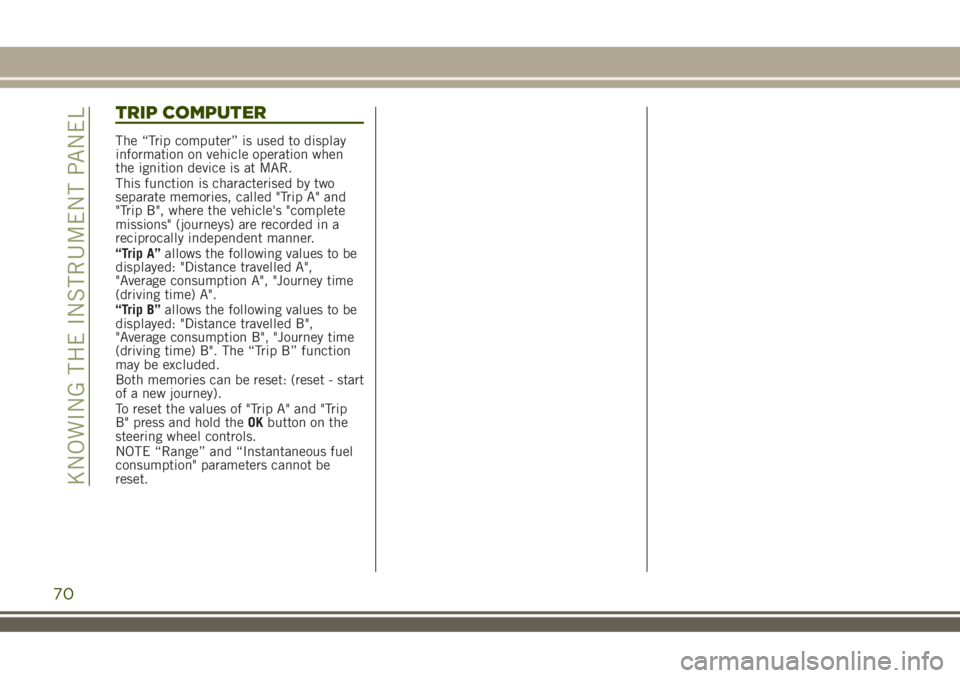
TRIP COMPUTER
The “Trip computer” is used to display
information on vehicle operation when
the ignition device is at MAR.
This function is characterised by two
separate memories, called "Trip A" and
"Trip B", where the vehicle's "complete
missions" (journeys) are recorded in a
reciprocally independent manner.
“Trip A”allows the following values to be
displayed: "Distance travelled A",
"Average consumption A", "Journey time
(driving time) A".
“Trip B”allows the following values to be
displayed: "Distance travelled B",
"Average consumption B", "Journey time
(driving time) B". The “Trip B” function
may be excluded.
Both memories can be reset: (reset - start
of a new journey).
To reset the values of "Trip A" and "Trip
B" press and hold theOKbutton on the
steering wheel controls.
NOTE “Range” and “Instantaneous fuel
consumption" parameters cannot be
reset.
70
KNOWING THE INSTRUMENT PANEL
Page 74 of 356
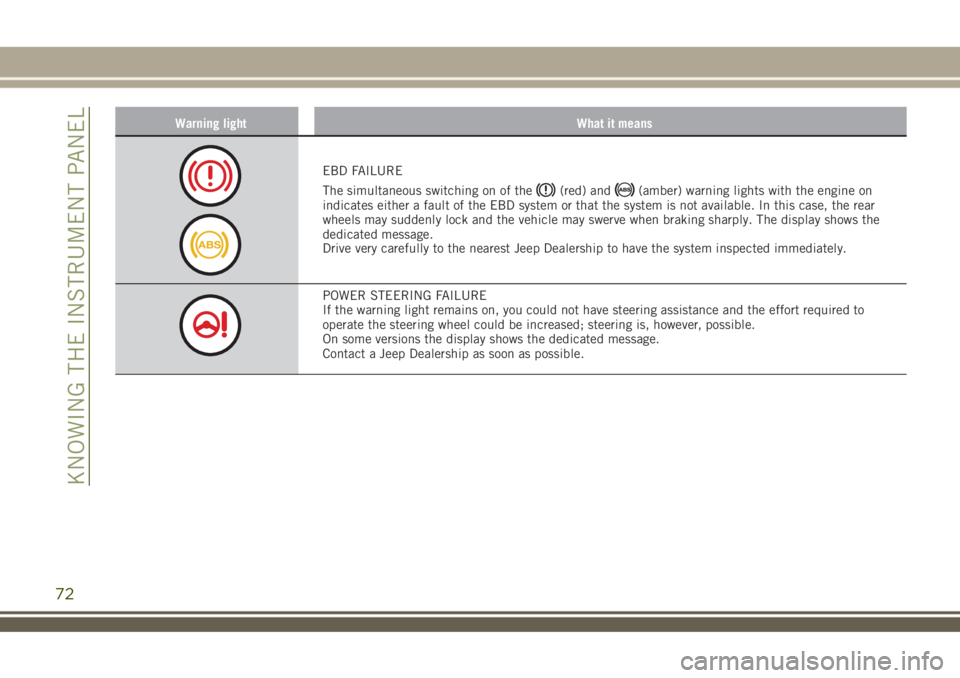
Warning light What it means
EBD FAILURE
The simultaneous switching on of the
(red) and(amber) warning lights with the engine on
indicates either a fault of the EBD system or that the system is not available. In this case, the rear
wheels may suddenly lock and the vehicle may swerve when braking sharply. The display shows the
dedicated message.
Drive very carefully to the nearest Jeep Dealership to have the system inspected immediately.
POWER STEERING FAILURE
If the warning light remains on, you could not have steering assistance and the effort required to
operate the steering wheel could be increased; steering is, however, possible.
On some versions the display shows the dedicated message.
Contact a Jeep Dealership as soon as possible.
72
KNOWING THE INSTRUMENT PANEL
Page 77 of 356
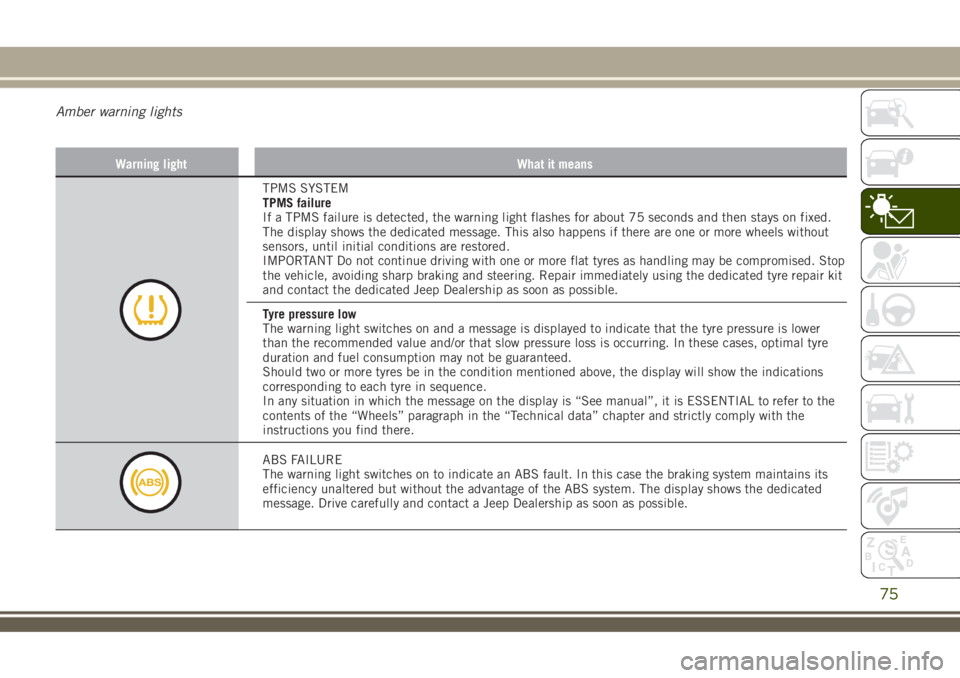
Amber warning lights
Warning light What it means
TPMS SYSTEM
TPMS failure
If a TPMS failure is detected, the warning light flashes for about 75 seconds and then stays on fixed.
The display shows the dedicated message. This also happens if there are one or more wheels without
sensors, until initial conditions are restored.
IMPORTANT Do not continue driving with one or more flat tyres as handling may be compromised. Stop
the vehicle, avoiding sharp braking and steering. Repair immediately using the dedicated tyre repair kit
and contact the dedicated Jeep Dealership as soon as possible.
Tyre pressure low
The warning light switches on and a message is displayed to indicate that the tyre pressure is lower
than the recommended value and/or that slow pressure loss is occurring. In these cases, optimal tyre
duration and fuel consumption may not be guaranteed.
Should two or more tyres be in the condition mentioned above, the display will show the indications
corresponding to each tyre in sequence.
In any situation in which the message on the display is “See manual”, it is ESSENTIAL to refer to the
contents of the “Wheels” paragraph in the “Technical data” chapter and strictly comply with the
instructions you find there.
ABS FAILURE
The warning light switches on to indicate an ABS fault. In this case the braking system maintains its
efficiency unaltered but without the advantage of the ABS system. The display shows the dedicated
message. Drive carefully and contact a Jeep Dealership as soon as possible.
75
Page 82 of 356
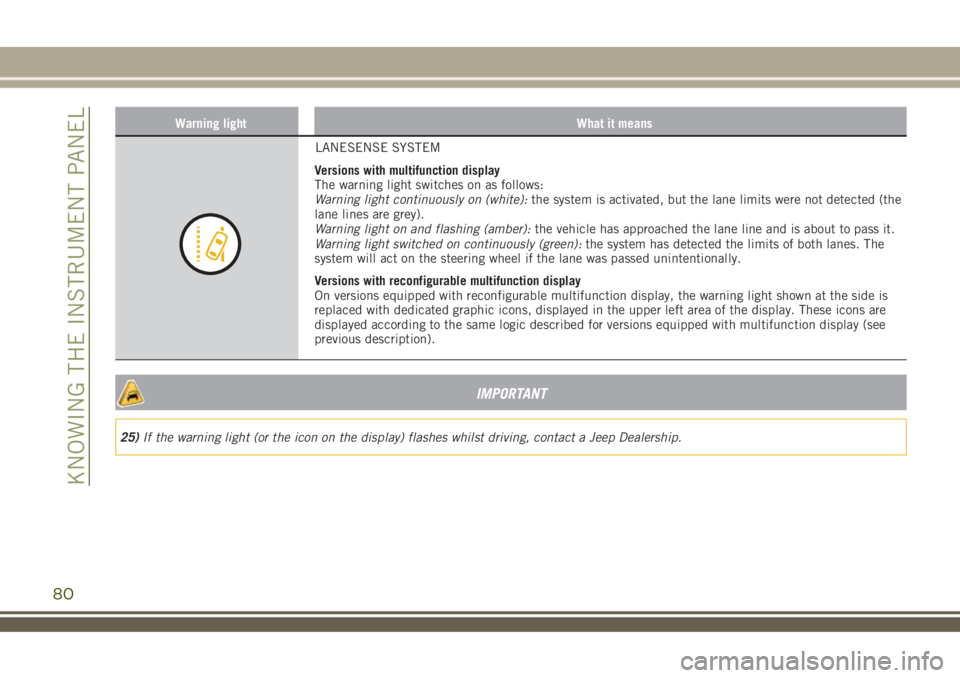
Warning light What it means
LANESENSE SYSTEM
Versions with multifunction display
The warning light switches on as follows:
Warning light continuously on (white):the system is activated, but the lane limits were not detected (the
lane lines are grey).
Warning light on and flashing (amber):the vehicle has approached the lane line and is about to pass it.
Warning light switched on continuously (green):the system has detected the limits of both lanes. The
system will act on the steering wheel if the lane was passed unintentionally.
Versions with reconfigurable multifunction display
On versions equipped with reconfigurable multifunction display, the warning light shown at the side is
replaced with dedicated graphic icons, displayed in the upper left area of the display. These icons are
displayed according to the same logic described for versions equipped with multifunction display (see
previous description).
IMPORTANT
25)If the warning light (or the icon on the display) flashes whilst driving, contact a Jeep Dealership.
80
KNOWING THE INSTRUMENT PANEL
Page 101 of 356
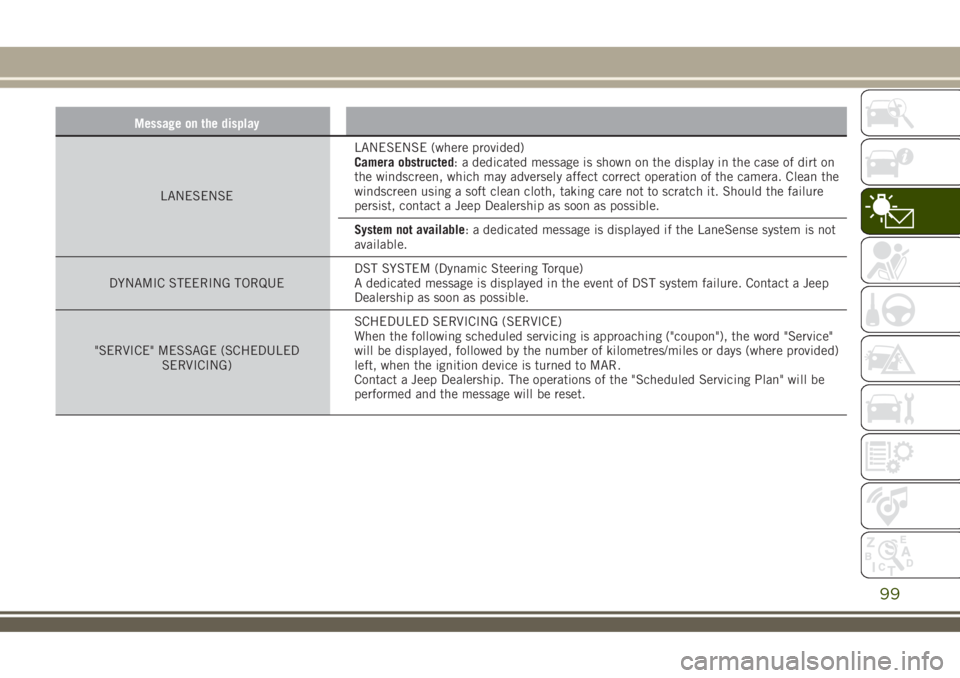
Message on the display
LANESENSELANESENSE (where provided)
Camera obstructed: a dedicated message is shown on the display in the case of dirt on
the windscreen, which may adversely affect correct operation of the camera. Clean the
windscreen using a soft clean cloth, taking care not to scratch it. Should the failure
persist, contact a Jeep Dealership as soon as possible.
System not available: a dedicated message is displayed if the LaneSense system is not
available.
DYNAMIC STEERING TORQUEDST SYSTEM (Dynamic Steering Torque)
A dedicated message is displayed in the event of DST system failure. Contact a Jeep
Dealership as soon as possible.
"SERVICE" MESSAGE (SCHEDULED
SERVICING)SCHEDULED SERVICING (SERVICE)
When the following scheduled servicing is approaching ("coupon"), the word "Service"
will be displayed, followed by the number of kilometres/miles or days (where provided)
left, when the ignition device is turned to MAR.
Contact a Jeep Dealership. The operations of the "Scheduled Servicing Plan" will be
performed and the message will be reset.
99
Page 104 of 356
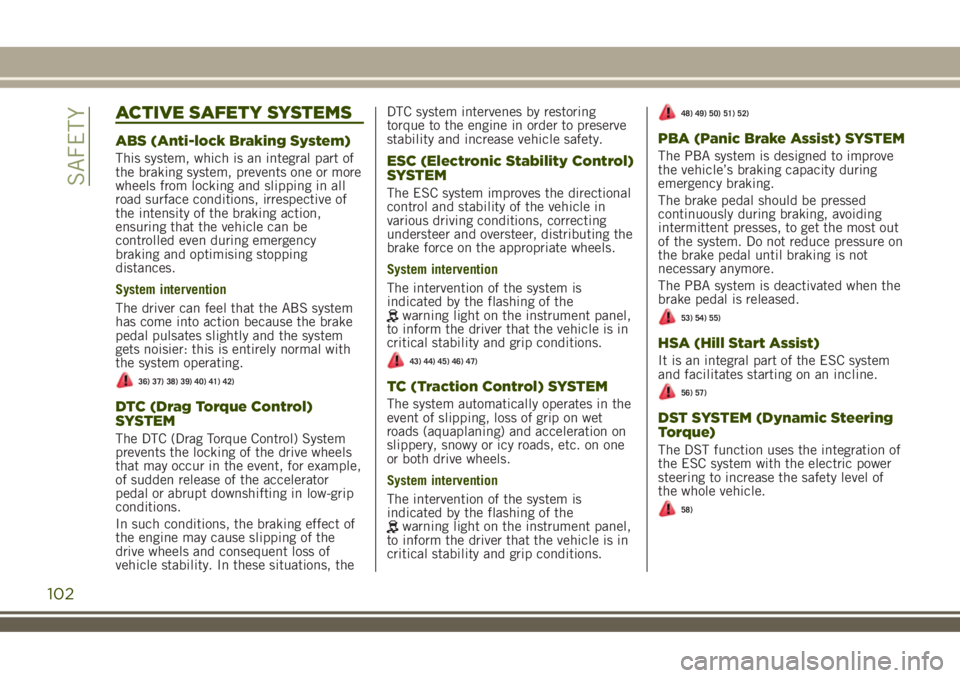
ACTIVE SAFETY SYSTEMS
ABS (Anti-lock Braking System)
This system, which is an integral part of
the braking system, prevents one or more
wheels from locking and slipping in all
road surface conditions, irrespective of
the intensity of the braking action,
ensuring that the vehicle can be
controlled even during emergency
braking and optimising stopping
distances.
System intervention
The driver can feel that the ABS system
has come into action because the brake
pedal pulsates slightly and the system
gets noisier: this is entirely normal with
the system operating.
36) 37) 38) 39) 40) 41) 42)
DTC (Drag Torque Control)
SYSTEM
The DTC (Drag Torque Control) System
prevents the locking of the drive wheels
that may occur in the event, for example,
of sudden release of the accelerator
pedal or abrupt downshifting in low-grip
conditions.
In such conditions, the braking effect of
the engine may cause slipping of the
drive wheels and consequent loss of
vehicle stability. In these situations, theDTC system intervenes by restoring
torque to the engine in order to preserve
stability and increase vehicle safety.
ESC (Electronic Stability Control)
SYSTEM
The ESC system improves the directional
control and stability of the vehicle in
various driving conditions, correcting
understeer and oversteer, distributing the
brake force on the appropriate wheels.
System intervention
The intervention of the system is
indicated by the flashing of the
warning light on the instrument panel,
to inform the driver that the vehicle is in
critical stability and grip conditions.
43) 44) 45) 46) 47)
TC (Traction Control) SYSTEM
The system automatically operates in the
event of slipping, loss of grip on wet
roads (aquaplaning) and acceleration on
slippery, snowy or icy roads, etc. on one
or both drive wheels.
System intervention
The intervention of the system is
indicated by the flashing of the
warning light on the instrument panel,
to inform the driver that the vehicle is in
critical stability and grip conditions.
48) 49) 50) 51) 52)
PBA (Panic Brake Assist) SYSTEM
The PBA system is designed to improve
the vehicle’s braking capacity during
emergency braking.
The brake pedal should be pressed
continuously during braking, avoiding
intermittent presses, to get the most out
of the system. Do not reduce pressure on
the brake pedal until braking is not
necessary anymore.
The PBA system is deactivated when the
brake pedal is released.
53) 54) 55)
HSA (Hill Start Assist)
It is an integral part of the ESC system
and facilitates starting on an incline.
56) 57)
DST SYSTEM (Dynamic Steering
Torque)
The DST function uses the integration of
the ESC system with the electric power
steering to increase the safety level of
the whole vehicle.
58)
102
SAFETY
Page 105 of 356
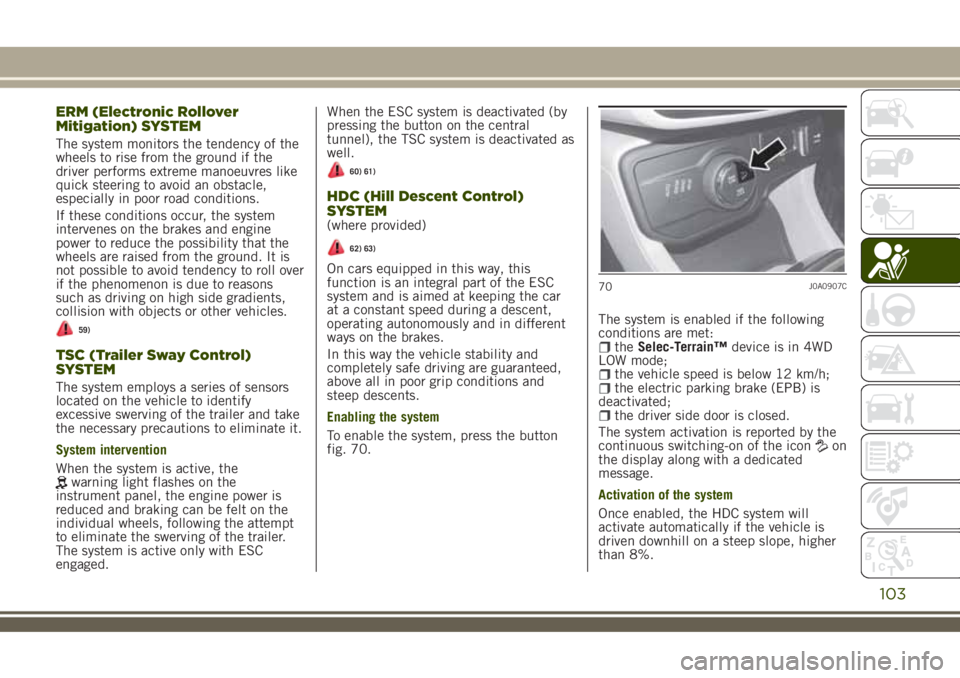
ERM (Electronic Rollover
Mitigation) SYSTEM
The system monitors the tendency of the
wheels to rise from the ground if the
driver performs extreme manoeuvres like
quick steering to avoid an obstacle,
especially in poor road conditions.
If these conditions occur, the system
intervenes on the brakes and engine
power to reduce the possibility that the
wheels are raised from the ground. It is
not possible to avoid tendency to roll over
if the phenomenon is due to reasons
such as driving on high side gradients,
collision with objects or other vehicles.
59)
TSC (Trailer Sway Control)
SYSTEM
The system employs a series of sensors
located on the vehicle to identify
excessive swerving of the trailer and take
the necessary precautions to eliminate it.
System intervention
When the system is active, the
warning light flashes on the
instrument panel, the engine power is
reduced and braking can be felt on the
individual wheels, following the attempt
to eliminate the swerving of the trailer.
The system is active only with ESC
engaged.When the ESC system is deactivated (by
pressing the button on the central
tunnel), the TSC system is deactivated as
well.
60) 61)
HDC (Hill Descent Control)
SYSTEM
(where provided)
62) 63)
On cars equipped in this way, this
function is an integral part of the ESC
system and is aimed at keeping the car
at a constant speed during a descent,
operating autonomously and in different
ways on the brakes.
In this way the vehicle stability and
completely safe driving are guaranteed,
above all in poor grip conditions and
steep descents.
Enabling the system
To enable the system, press the button
fig. 70.The system is enabled if the following
conditions are met:
theSelec-Terrain™device is in 4WD
LOW mode;
the vehicle speed is below 12 km/h;the electric parking brake (EPB) is
deactivated;
the driver side door is closed.
The system activation is reported by the
continuous switching-on of the icon
on
the display along with a dedicated
message.
Activation of the system
Once enabled, the HDC system will
activate automatically if the vehicle is
driven downhill on a steep slope, higher
than 8%.
70J0A0907C
103
Page 115 of 356

sealants may damage the Tyre Pressure
Monitoring System sensor. If
aftermarket tyre sealant has been
used, it is recommended to go to a
Jeep Dealership to have the sensors
checked. After checking or adjusting
the tyre pressure, always refit the valve
cap to prevent humidity and dirt from
entering. They could damage the Tyre
Pressure Monitoring System sensor.
NOTE Some external factors (e.g.
external temperature, etc...) could affect
the information reported on the
instrument panel by the TPMS.
The tyre inflation pressure and the “low
pressure” reporting threshold could
change depending on the environmental
conditions.
TPMS check message
If a system failure is present, the
warning light flashes for about
75 seconds and then stays on solid. An
acoustic signal is also emitted.
TPMS deactivation
The TPMS can be deactivated by
replacing the wheels equipped with
TPMS with others that are not (e.g. when
replacing the wheel assemblies in
winter), if the country of purchase allows
it. Then drive the vehicle for at least
20 minutes at a speed higher than about25 km/h. The TPMS will emit an
acoustic warning, the
warning light
will flash for about 75 seconds, then will
stay on constantly and the instrument
panel will display the "Tyre pressure not
available" message with some dashes (–
–) instead of the pressure values.
The next time the engine is started, the
system will not emit any acoustic signal
and the display will not show the
message "Tyre pressure not available",
but the dashes (– –) will be still
displayed instead of the pressure value.
Operating example
Supposing that the prescribed cold
inflation pressure (i.e. vehicle stationary
for at least 3 hours) is 2.3 bar, if the
ambient temperature is 20°C and the
detected tyre pressure is 1.95 bar, a
temperature reduction of −7°C results in
a decrease in tyre pressure, bringing it to
approximately 1.65 bar. This pressure is
sufficiently low to activate the
warning
light.
Heating of tyres due to driving the
vehicle may increase tyre pressure up to
approximately 1.95 bar, but the
warning light will stay on. In this
situation, the warning light will switch off
only after the tyres are inflated to the
prescribed cold pressure value for the
car.
WARNING
68)The system is an aid for vehicle
driving, it DOES NOT warn the driver
about incoming vehicles outside of the
detection areas. The driver must always
maintain a sufficient level of attention to
the traffic and road conditions and for
controlling the trajectory of the vehicle.
69)The system is an aid for the driver,
who must always pay full attention while
driving. The responsibility always rests
with the driver, who must take into
account the traffic conditions in order to
drive in complete safety. The driver must
always maintain a safe distance from the
vehicle in front.
70)If the driver depresses the brake pedal
fully or carries out a fast steering during
system operation, the automatic braking
function may stop (e.g. to allow a possible
manoeuvre to avoid the obstacle).
71)The system intervenes on vehicles
travelling in the same lane. People,
animals and things (e.g. pushchairs) are
not taken into consideration.
113
Page 116 of 356
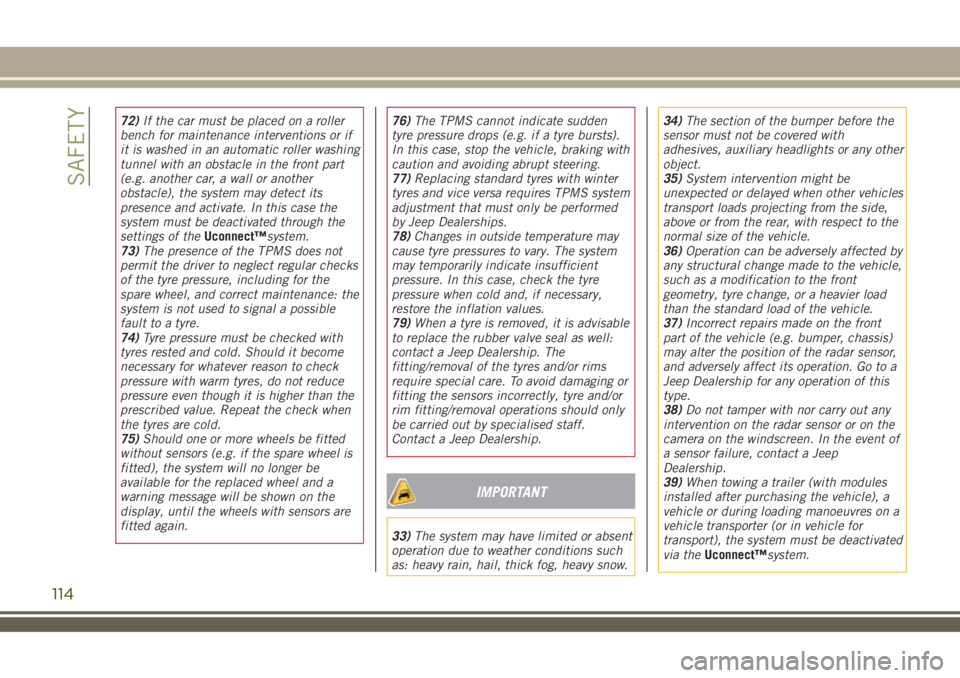
72)If the car must be placed on a roller
bench for maintenance interventions or if
it is washed in an automatic roller washing
tunnel with an obstacle in the front part
(e.g. another car, a wall or another
obstacle), the system may detect its
presence and activate. In this case the
system must be deactivated through the
settings of theUconnect™system.
73)The presence of the TPMS does not
permit the driver to neglect regular checks
of the tyre pressure, including for the
spare wheel, and correct maintenance: the
system is not used to signal a possible
fault to a tyre.
74)Tyre pressure must be checked with
tyres rested and cold. Should it become
necessary for whatever reason to check
pressure with warm tyres, do not reduce
pressure even though it is higher than the
prescribed value. Repeat the check when
the tyres are cold.
75)Should one or more wheels be fitted
without sensors (e.g. if the spare wheel is
fitted), the system will no longer be
available for the replaced wheel and a
warning message will be shown on the
display, until the wheels with sensors are
fitted again.76)The TPMS cannot indicate sudden
tyre pressure drops (e.g. if a tyre bursts).
In this case, stop the vehicle, braking with
caution and avoiding abrupt steering.
77)Replacing standard tyres with winter
tyres and vice versa requires TPMS system
adjustment that must only be performed
by Jeep Dealerships.
78)Changes in outside temperature may
cause tyre pressures to vary. The system
may temporarily indicate insufficient
pressure. In this case, check the tyre
pressure when cold and, if necessary,
restore the inflation values.
79)When a tyre is removed, it is advisable
to replace the rubber valve seal as well:
contact a Jeep Dealership. The
fitting/removal of the tyres and/or rims
require special care. To avoid damaging or
fitting the sensors incorrectly, tyre and/or
rim fitting/removal operations should only
be carried out by specialised staff.
Contact a Jeep Dealership.
IMPORTANT
33)The system may have limited or absent
operation due to weather conditions such
as: heavy rain, hail, thick fog, heavy snow.34)The section of the bumper before the
sensor must not be covered with
adhesives, auxiliary headlights or any other
object.
35)System intervention might be
unexpected or delayed when other vehicles
transport loads projecting from the side,
above or from the rear, with respect to the
normal size of the vehicle.
36)Operation can be adversely affected by
any structural change made to the vehicle,
such as a modification to the front
geometry, tyre change, or a heavier load
than the standard load of the vehicle.
37)Incorrect repairs made on the front
part of the vehicle (e.g. bumper, chassis)
may alter the position of the radar sensor,
and adversely affect its operation. Go to a
Jeep Dealership for any operation of this
type.
38)Do not tamper with nor carry out any
intervention on the radar sensor or on the
camera on the windscreen. In the event of
a sensor failure, contact a Jeep
Dealership.
39)When towing a trailer (with modules
installed after purchasing the vehicle), a
vehicle or during loading manoeuvres on a
vehicle transporter (or in vehicle for
transport), the system must be deactivated
via theUconnect™system.
114
SAFETY